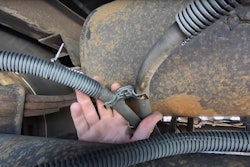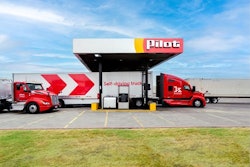Western Star in August 2022 rolled out the third model in its X-Series lineup – the on-highway 57X.
Since its 2020 pivot to become Daimler Truck North America's vocational brand, Western Star has launched models 49X and 47X but the 57X marks an about-face from the jobsite.
The 57X replaces the 5700XE – Western Star's first foray into aero market that debuted in 2014 and starred as Optimus Prime in the Transformer franchise that same year. The model 5700XE was discontinued at the end of last year.
The 57X is the most fuel-efficient model Western Star has ever built – 5.8% more fuel-efficient than its predecessor. About half of those gains come from an aerodynamic retooling and the other half from a powertrain comprised exclusively of Detroit products.
In the video above, ride along with CCJ Chief Editor Jason Cannon as he takes a spin around the Detroit-Metro area, and hear from product experts Clint LaPreze and Ryan Major about some of the highlights of Western Star's newest model.
[Related: Test driving Western Star 57X]
In this video
00:00 - Intro
00:34 - Bumper, lights, safety features, & automated driving
02:23 - Hood, air intake, mirrors, & visibility
03:36 - Interior
04:12 - Dashboard overview
07:18 - How does the inside look & feel?

07:59 - Aerodynamics & MPG
08:55 - Conclusion
Video transcript
Jason Cannon
Hey everybody. CCJ chief editor Jason Cannon here. My guest is Western Star's New 57X. This is the replacement for the 5700. This truck right here has a DD15. We've got about 505 horsepower to play with, and we're dragging around about 80,000 pounds. We're about to take a tour of the Detroit Metropolitan Area in this baby right here. Hopefully, in this configuration, we can get somewhere in the neighborhood of eight to nine miles per gallon. We'll just kind of have to see. This is Detroit and traffic is reality, but I'll catch you guys on the other side.
Ryan Major
All right. So start off with the front. We have a two piece aerodynamic bumper with functional air ducts. Moving up from there, we have a dual stage intelligent heated LED headlamps. So this will follow suit with what we did with 49X and 47X as well. So heated LED headlights. Talking about safety systems; your forward radar is going to be located down here for Detroit 5.0, and then our camera system is mounted in the windshield up that way.
Jason Cannon
We are sitting in some pretty aggressive traffic here on Interstate 94. We've been in this mess for about 30 minutes and probably for the last 25 minutes I've had on the automatic cruise control with my feet planted firmly on the floorboard. When traffic inches up a little bit, the truck inches up a little bit. I don't really have to do anything except right now I've been sitting here for a little bit longer than two seconds so that gap's not going to close. I just have to bump the accelerator. My foot's back on the floor, and now the truck's pacing the van that's in front of us right now. That van's about 40 feet away. We'll get us close to about maybe 10 to 15 feet. The truck is doing four miles an hour. Right now you can see the van's starting to brake a little bit.
We are still holding on to that 39 feet. We're at 33 feet. Now we're down to two miles an hour. And if that van were to stop, this truck is going to stop. Again my feet are firmly planted on the floor. My hands aren't really on the steering wheel. They should be, but this is just sort of a demonstration that it's keeping itself in the lane and it's pacing itself with traffic. It looks like we're about to stop. My feet are on the ground and here we go; we are stopping. We didn't hit the van. The van's going to take off, and since we didn't stay here longer than two seconds, the truck starts itself and we're going to catch back up to the van.
Ryan Major
The hood itself is a three-piece hood. You'll notice in the video, we talked about the shared air intake and the C-loop mirrors that we're sharing with the 49X and 47X. So following suit there, it all fits in the family. Looking up from there, we have one piece windshield now. The 5,700 was a two piece windshield. This windshield's going to be 28% larger than the previous 5700, so a lot better visibility. The other thing we did to improve visibility – well, it was two things that helped us improve fuel efficiency as well – is the frame rails are splayed as well. So we were able to lower the engine, which gives us a little bit aerodynamics and better visibility at the same time.
Jason Cannon
One of the biggest, most noticeable changes going from the 5700 to the 57X is the windshield. There's not that middle divider in the two piece windshield. And I really like that. This is a big piece of glass and the splayed frame rails have allowed the engine to drop, which drops the hood. So the nose of the truck is almost not even there. I have excellent visibility. The passenger side, the driver's side windows, are one single, one big piece of glass. Whipping your head around, looking to the left, looking to the right, looking straight ahead. Visibility in this truck is excellent.
Ryan Major
On the previous generation sleepers, we offered an 82-inch sleeper with 5700. We will not offer that with this truck. The largest size will be the 72-inch sleeper. So even though it's 10 inches shorter, the volume is actually increased. So the volume will actually be about 22% larger than the previous 5700. So it is going to be extremely lighter than the 82 inch sleeper. Our early estimates are going to be somewhere around 1,000 pounds lighter than the 5700. If you compare it an 82-inch to the 72-inch sleeper, so a huge, huge gain there.
Clint LaPreze
So we'll talk about the digital dash display in the Western Star 57X. This consists of a 12-inch primary display for the driver and a 10-inch B-panel display. Now the B-panel display can be controlled one of three ways. It's a touchscreen operation or with home shortcut buttons on the bottom of the screen itself. It's all major key areas that a driver may need to access. It can also be controlled through the OFN – or optical finger navigation – unit on the right-hand side of the steering wheel. By swiping your finger along the OFN, it will change the cursor location on the screen. The center button allows the driver to access that menu very quick and easy between three levels of operation. Moving over to the primary display. The primary display consists of three primary stacks controlled solely through the left-hand steering wheel control. Again, swiping left or right on the OFN allows me to select what I want to see in different areas. Swiping left or right changes the location, up-and-down changes the menu options.
I swipe down once on the left hand side. I get my temperature and my oil pressure. Swiping down again gives me my axle temperature, readings, so on and so forth through five different menu settings. If I swipe to the right, it takes me back to the center display area where I can choose the information I would like to see here. I have two options here. I can select an option that just shows me my miles per hour and my RPM readings or, if I swipe down, that's the driver assistance screen where, if we were out on the road, it would show the vehicle in front of us. Swiping over to the left provides the entertainment or trip information for the driver. Swipe down once and it shows trip information a second time, lifetime fuel consumption and radio information, and if the driver does have a phone paired with the system they can control the device, music and phone operation there.
The steering wheel controls consist of many different common features for the driver. You have your set speed for cruise control and resume on the left-hand side, a back button, a cancellation and a marker interrupt. On the upper right-hand corner you see this control with two squares, or two cards, if you will. And if I click that, it allows me to have quick menu access to adjust my following distance or my lane bias for active lane assist. If I press it again, it provides me control for intelligent powertrain management with the upper and lower history values. To exit the menu I can press the back button. Moving over to the right hand side of the steering wheel. I have the option for phone receive or hang up, a secondary back button, a mute, and a volume up and a volume down.
Jason Cannon
So this truck is marketed – or geared towards – small fleets and owner operators, which means some of the creature comforts, and the way it looks and the way it feels, are going to be exponentially important. And I will tell you, the inside of this truck is about as nice as any truck I've ever been in. There's really no way to basic this truck out. It starts at a very premium level. The seats are ridiculously comfortable, really nice, and the diamond inserts and the stitching – this is just a good looking truck. A big sleeper in the back. I wouldn't have a lot of problem living in this truck for extended periods of time. Hopefully we'll just keep going when we try to drop it off and I may live in it for the next couple of days.
Ryan Major
We're focusing on aerodynamics with this truck. So we have the full chassis side faring here. And the back of the cab we have the 24-inch side extenders that will be standard. And in the video you saw the optimized roof faring. On the back drive wheels you'll see flow below driveway covers will be standard. And then we'll also offer optional drive fairings too. So with aerodynamics and the powertrain improvements, customers will see an improvement of 5.8% fuel economy improvements over the previous 5700.
Jason Cannon
All right, so we've concluded about a 65 mile test drive here. My average fuel economy was 7.6 mpg. I had that as high as 7.8. I sort of blew that out a little bit on the couple of miles or so back to the base. This is a nine mile per gallon truck, probably, all day long. We weren't able to wash out 45 minutes that we spent sitting in some pretty heavy stop and go traffic. And over the course of the rest of the 60-ish or so miles, we just weren't able to pull that out. Overall impression of this truck is this is a premium truck, make no mistake. This is not a base model, entry-level. Maybe you don't want to call it, everyday driver, because this is a special truck.
If I'm an owner operator, if I'm a small fleet, and I'm really looking for a premium driving experience – maybe I'm looking for a reward truck – this is absolutely that. It is comfortable. I think I've mentioned before that it's cliche to say that these trucks have a very automotive feel. This truck has a very automotive feel from the fit and finish, which is super premium, to the technology in play, the lane centering technology. This is just a very nice, very safe truck.









